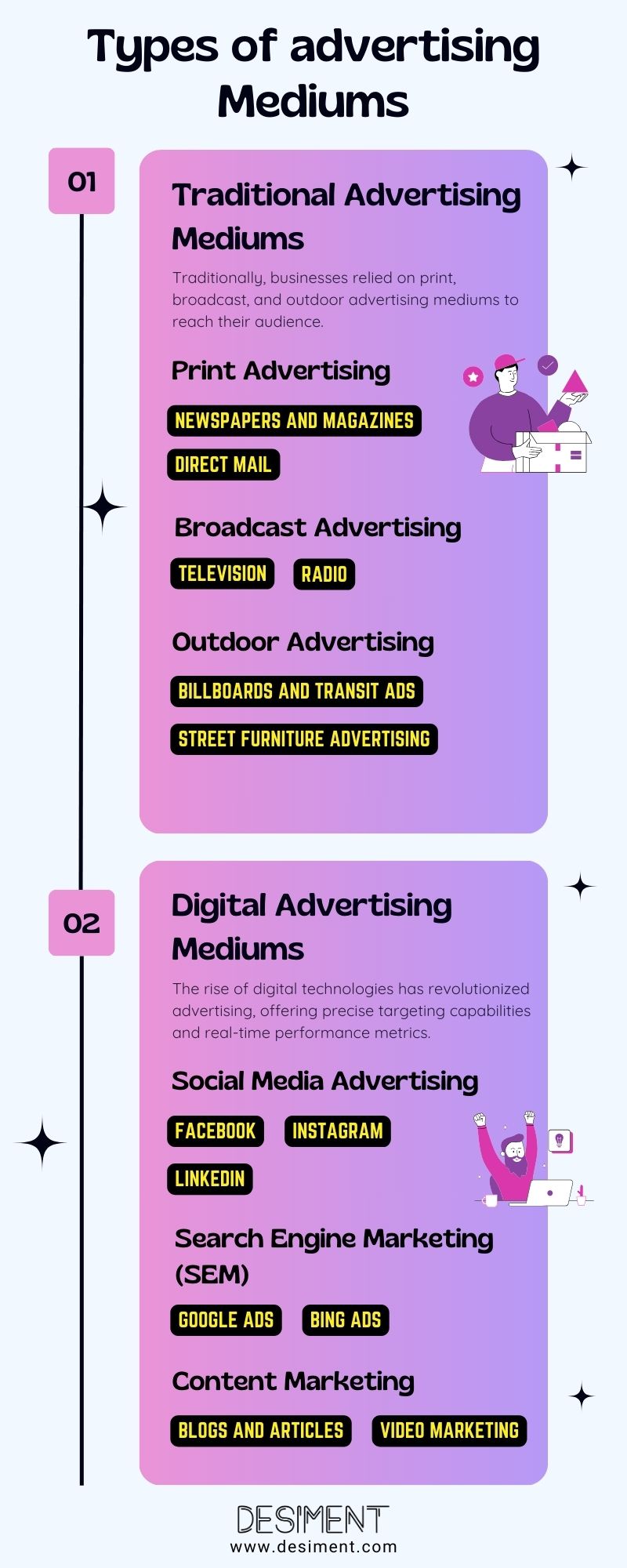In today’s digitally interconnected world, effective advertising is essential for businesses looking to connect with their target audience. With the evolution of advertising mediums, there are now a variety of channels available to reach consumers of all demographics and preferences.
To create successful advertising campaigns, businesses need to understand these mediums and their effectiveness. By leveraging the right channels, businesses can maximize their reach and impact on consumers.
Exploring Two Worlds: Traditional and Digital Advertising Mediums
Both traditional and digital advertising mediums have their advantages and disadvantages, and the best approach for a business will depend on its target audience, budget, and marketing goals.
Combining both traditional and digital mediums in an integrated marketing campaign can help reach a larger and more diverse audience and achieve better results.

Introduction to Advertising Mediums
Advertising mediums encompass the various channels and platforms through which businesses communicate their messages to potential customers.
These mediums range from traditional methods such as print and broadcast to modern digital platforms including social media and search engine marketing.
Each medium offers unique advantages and appeals to different audience segments based on demographics, behaviour, and consumption habits.
Traditional Advertising Mediums
Traditionally, businesses relied on print, broadcast, and outdoor advertising mediums to reach their audience:
1. Print Advertising:
- Newspapers and Magazines: Print media offers targeted advertising opportunities based on readership demographics and interests. It remains effective for local businesses aiming to reach a specific geographic audience.
- Direct Mail: Sending promotional materials directly to consumers’ mailboxes allows for personalized messaging and can yield high response rates when tailored effectively.
2. Broadcast Advertising:
- Television: TV ads are impactful due to their audiovisual nature, reaching a broad audience simultaneously. They are effective for creating brand awareness and are often used during prime-time slots to maximize viewership.
- Radio: Radio advertising targets listeners based on their preferred stations and genres, offering a cost-effective way to reach segmented audiences, especially during commute times.
3. Outdoor Advertising:
- Billboards and Transit Ads: Placed strategically in high-traffic areas, billboards and transit ads capture the attention of commuters and pedestrians, delivering brand messages in a succinct and visually compelling manner.
- Street Furniture Advertising: Utilizing bus shelters, benches, and other street fixtures allows for localized targeting and enhances brand visibility in urban environments.
Digital Advertising Mediums
The rise of digital technologies has revolutionized advertising, offering precise targeting capabilities and real-time performance metrics:
1. Social Media Advertising:
- Facebook: With its extensive user base and sophisticated targeting options, Facebook ads allow businesses to reach specific demographics based on interests, behaviours, and location.
- Instagram: Ideal for visual-centric campaigns, Instagram ads leverage the platform’s visual appeal to engage users through compelling images and videos.
- LinkedIn: LinkedIn ads target professionals and B2B audiences and enable businesses to promote thought leadership content, generate leads, and build industry influence.
2. Search Engine Marketing (SEM):
- Google Ads: Through pay-per-click (PPC) advertising, businesses bid on keywords related to their products or services, appearing prominently in search engine results pages (SERPs). This method ensures visibility to users actively searching for relevant information.
3. Content Marketing:
- Blogs and Articles: Publishing informative content on owned platforms or guest posting on reputable sites helps businesses establish authority in their industry, driving organic traffic and enhancing brand credibility.
- Video Marketing: Platforms like YouTube facilitate video advertising, allowing businesses to showcase product demonstrations, customer testimonials, and engaging storytelling to captivate audiences.
Evaluating Effectiveness and ROI
Assessing the effectiveness of advertising mediums involves analyzing key performance indicators (KPIs) such as:
- Reach and Impressions: Measuring the number of people exposed to the advertisement.
- Engagement: Tracking interactions such as clicks, likes, shares, and comments.
- Conversion Rates: Calculating the percentage of users who complete desired actions such as making a purchase or signing up for a newsletter.
- ROI (Return on Investment): Evaluating the profitability of the advertising campaign by comparing the costs incurred to the revenue generated.
Choosing the Right Mediums for Your Business
Selecting the most suitable advertising mediums depends on various factors including:
- Target Audience: Understanding demographic profiles, interests, and online behaviour helps determine which platforms are most likely to reach and resonate with your audience.
- Campaign Objectives: Aligning advertising strategies with specific goals such as brand awareness, lead generation, or sales conversion ensures focused and effective campaigns.
- Budget Considerations: Balancing cost-effectiveness with the desired reach and impact helps optimize advertising spend and maximize ROI.
Case Studies and Examples
Case Study 1: Coca-Cola’s Integrated Campaign
- Coca-Cola successfully integrates traditional and digital mediums by combining TV commercials during major events with social media campaigns. This approach maximizes audience reach and engagement across diverse channels.
Case Study 2: Dollar Shave Club’s Viral Video
- Dollar Shave Club’s humorous viral video campaign on YouTube showcases the power of digital platforms in reaching a global audience and generating widespread brand awareness.
Conclusion
Effective advertising mediums play a pivotal role in connecting businesses with their target audience, driving brand awareness, engagement, and ultimately, revenue growth.
By leveraging a mix of traditional and digital channels, businesses can enhance their visibility, engage with consumers across multiple touchpoints, and achieve their marketing objectives effectively.
Understanding the strengths and characteristics of each advertising medium empowers businesses to craft strategic campaigns that resonate with their audience and deliver measurable results in today’s competitive marketplace.





